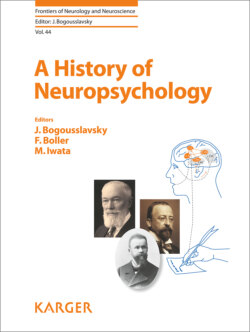Читать книгу A History of Neuropsychology - Группа авторов - Страница 76
На сайте Литреса книга снята с продажи.
References
Оглавление1Broca P: Perte de la parole, ramollissement chronique et destruction partielle du lobe antérieur gauche du cerveau. Bull Soc Anthropol (Paris) 1861;2:235–238.
2Geschwind N: Disconnexion syndromes in animals and man. Brain 1965;88:237–294, 585–644.
3Henderson VW: Alexia and agraphia. Handb Clin Neurol 2010;95:583–601.
4Henderson VW: History of disorders of writing and reading; in Barr WB, Bieliauskas LA (eds): The Oxford Handbook of History of Clinical Neuropsychology. Oxford, Oxford University Press, 2018.
5Gall FJ: Sur les Fontions du Cerveau, vol 5. Organologie ou Exposition des Instincts, des Penchans, des Sentimens et des Talens, ou des Qualités Morales et des Facultés Intellectuelles Fondamentales de l’Homme et des Animaux, et du Siége de leurs Organes. Paris, J-B Ballière, 1825.
6Bouillaud J: Recherches cliniques propres à démontrer que la perte de la parole correspond à la lésion des lobules antérieurs du cerveau, et à confirmer l’opinion de M. Gall, sur le siège de l’organe du langage articulé. Arch Gen Med 1825;8:25–45.
7Marcé LV: Mémoire sur quelques observations de physiologie pathologique tendant a démontrer l’existence d’un principe coordinateur de l’écriture et ses rapports avec le principe coordinateur de la parole. C R Mem Séances Soc Bio (Paris) 1856;3:93–115.
8Aubertin E: Reprise de la discussion sur la forme et le volume du cerveau. Bull Soc Anthropol (Paris) 1861;2:209–220.
9Broca P: Remarques sur le siège de la faculté du langage articulé, suivies d’une observation d’aphémie (perte de la parole). Bull Soc Anatom (Paris) 1861;6 (2nd series):330–357.
10Henderson VW: Alalia, aphemia, and aphasia. Arch Neurol 1990;47:85–88.
11Broca P: Sur le siége de la faculté du langage articulé. Bull Soc Anthropol (Paris) 1865;6:377–393.
12Henderson VW: Paul Broca’s less heralded contributions to aphasia research. Historical perspective and contemporary relevance. Arch Neurol 1986;43:609–612.
13Trousseau A: De l’aphasie, maladie décrite récemment sous le nom impropre d’aphémie. Gaz Hop Civ Milit 1864;37:13–14, 25–26, 37–39, 49–50.
14Trousseau A: Clinique Médicale de l’Hôtel-Dieu de Paris, ed 2, vol 2. Paris, J.-B. Ballière et Fils, 1865.
15Benedikt M: Über Aphasie, Agraphie und verwandte pathologische Zustände. Wiener Med Presse 1865;6:897–899, 923–926, 945–948, 997–999, 1020–1022, 1067–1070, 1094–1097, 1139–1142, 1167–1169, 1189–1190, 1264–1265.
16Ogle W: Aphasia and agraphia. St George Hosp Rep 1867;2:83–122.
17Wernicke C: Der Aphasische Symptomencomplex. Eine Psychologische Studie auf Anatomischer Basis. Breslau, Max Cohn & Weigert, 1874.
18Henderson VW: Sigmund Freud and the diagram-maker school of aphasiology. Brain Lang 1992;43:19–41.
19Henderson VW: Alexia and agraphia: contrasting perspectives of J.-M. Charcot and J. Hughlings Jackson. Neurology 2008;70:391–400.
20Hughlings Jackson J: On the nature of the duality of the brain. Med Press Circ 1874;17 (new series):19–21, 41–44, 63–65.
21Hughlings Jackson J: Loss of speech: its association with valvular disease of the heart and with hemiplegia on the right side. – Defects of smell. – Defects of speech in chorea. – Arterial lesions in epilepsy. Clin Lect Rep Med Surg Staff London Hosp 1864;1:388–471.
22Hughlings Jackson J: On affections of speech from disease of the brain. Brain 1878;1,2:304–330, 203–222, 323–356.
23Hughlings Jackson J: On the physiology of language. Med Times Gaz 1868;54:275–276.
24Bastian HC: On the various forms of loss of speech in cerebral disease. Brit Foreign Med Chirurg Rev 1869;43:209–236, 470–492.
25Kussmaul A: Disturbances of speech. An attempt in the pathology of speech; in von Ziemssen H (ed): Cyclopedia of the Practice of Medicine, vol 14. Diseases of the Nervous System, and Disturbances of Speech. New York, William Wood and Company, 1877, pp 581–893.
26Skwortzoff N: De la Cécité et de la Surdité des Mots dans l’Aphasie. Paris, Delahaye et Lecrosnier, 1881.
27Ferrier D: The Croonian lecture. Experiments on the brain of monkeys. Philosophical transactions of the royal society of London series B. Biol Sci 1875;165:433–488.
28Exner S: Untersuchungen über die Localisation der Functionen in der Grosshirnrinde des Menschen. Vienna, W. Braumuller, 1881.
29Bastian HC: On different kinds of aphasia, with special reference to their classification and ultimate pathology. Brit Med J 1887;2:931–936, 985–990.
30Marie P: De l’aphasie en général et de l’agraphie en particulier, d’après l’enseignement de M le professeur Charcot. Prog Med 1888;7(2nd series):81–84.
31Charcot JM: Des différentes formes de l’aphasie [collated by C Féré]. Prog Med 1883;11:441–444, 469–471, 487–488, 521–523, 859–861.
32Pitres A: Considérations sur l’agraphie. Rev Med 1884;4:855–873.
33Dejerine J: Contribution à l’étude des troubles de l’écriture chez les aphasiques. Mem Soc Biol 1891;43:97–113.
34Dejerine J: Sur un cas de cécité verbale avec agraphie, suivi d’autopsie. C R Séances Soc Biol 1891;43:197–201.
35Dejerine J: Contribution à l’étude anatomo-pathologique et clinique des différentes variétés de cécité verbale. C R Séances Mem Soc Biol 1892;44:61–90.
36Marie P: Revision de la question de l’aphasie: la troisième circonvolution frontale gauche ne joue aucun rôle spécial dans la fonction du langage. Semaine Med 1906;26:241–247.
37Marie P: Revision de la question de l’aphasie: que faut-il penser des aphasies sous-corticales (aphasies pures)? Semaine Med 1906;26:493–500.
38Marie P: L’évolution du langage considérée au point de vue de l’étude de l’aphasie. Presse Med 1897;5:397–399.
39Head H: Aphasia and Kindred Disorders of Speech. Cambridge, Cambridge University Press, 1926.
40Goldstein K: Language and Language Disturbances. New York, Grune and Stratton, 1948.
41Goldstein K: The Organism: A Holostic Approach to Biology Derived from Pathological Data in Man. New York, American Book Company, 1938.
42Liepmann H: Drei Aufsätze aus dem Apraxiegebiet. Berlin, Karger, 1908.
43Liepmann H, Maas O: Fall von linksseitiger Agraphie und Apraxie bei rechtseitiger Lämung. J Psychol Neurol 1907;10:214–227.
44Gazzaniga MS, Bogen JE, Sperry RW: Some functional effects of sectioning the cerebral commissures in man. Proc Natl Acad Sci U S A 1962;48:1765–1769.
45Geschwind N, Kaplan E: A human cerebral deconnection syndrome. A preliminary report. Neurology 1962;12:675–685.
46Geschwind N: The paradoxical position of Kurt Goldstein in the history of aphasia. Cortex 1964;1:214–224.
47Benson DF: The history of behavioral neurology. Neurol Clin 1993;11:1–8.
Victor W. Henderson, MD, MS
Departments of Health Research and Policy (Epidemiology) and of Neurology and Neurological Sciences
Stanford University
259 Campus Drive, HRP Redwood Building
Stanford, CA 94305-5405 (USA)
E-Mail vhenderson @ stanford.edu
